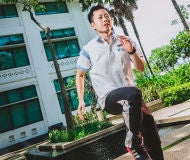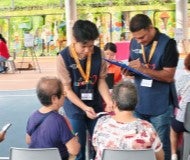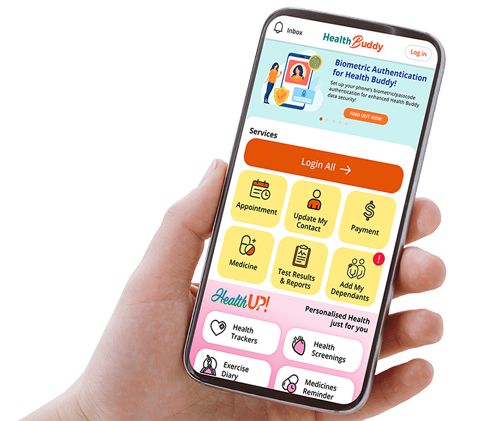Singapore General Hospital will NEVER ask you to transfer money over a call. If in doubt, call the 24/7 ScamShield helpline at 1799, or visit the ScamShield website at www.scamshield.gov.sg.
We’d love to hear from you! Rate the SGH website and share your feedback so we can enhance your online experience and serve you better. Click here to rate us
Acupuncture: All You Need to Know
Acupuncture is a Traditional Chinese Medicine (TCM) treatment modality that involves stimulation of certain point(s) on or near the surface of the human body through any technique of point stimulation (with or without the insertion of needles), including through the use of electrical, magnetic, light and sound energy, cupping and moxibustion (a technique that traditionally involves the burning of the leaves of a herb called mugwort). However, moxibustion and acupuncture using magnetic and/or sound energy will not be carried out in SingHealth.
Acupuncture involves inserting needles into various points on the body and manipulating them to promote the circulation of qi and blood, regulate the function of zang and fu organs and balance yin and yang, relieving pain or for other therapeutic purposes. Manipulation of the needles may give rise to a “de-qi” sensation which can be experienced as numbness, dull ache, or tingling at the needled sites that may radiate along the corresponding meridian. An infra-red heat lamp may also be placed over certain body areas at a height to introduce gentle heat.
Depending on the treatment plan, electro-acupuncture may also be used. Electro-acupuncture refers to the application of gentle pulsating electrical current to selected acupuncture needles as a means of stimulating the acupuncture points.
If applicable, ear acupuncture points may also be stimulated by needles or ear seeds (seeds from the Vaccaria plant). The ear seeds are taped over selected ear acupuncture points and usually left in place for up to 7 days.
Frequently Asked Questions about Acupuncture
Are the acupuncture needles sterile?
Acupuncturists use pre-sterilised, individually packaged disposable needles, thus ensuring that there is no transmission of communicable diseases between patients.
How deep do the needles penetrate?
The depth of needle penetration depends on the nature of the condition, the underlying anatomy of the points selected, the patient's built, age and constitution. In general, needles are inserted 1/4 to 1-inch deep.
What should I do before acupuncture treatment?
You should take note of the following:
- Maintain good personal hygiene to reduce the possibility of bacterial infection.
- Avoid wearing jewelry.
- Wear loose clothing (Women should not wear one-piece dresses and tight stockings)
- Avoid treatment when excessively fatigued, hungry or emotionally upset.
What should I do during acupuncture treatment?
You should:
- Relax and maintain a comfortable position.
- Do not move or change your body position unnecessarily.
- If you experience dizziness, nausea, cold sweat, shortness of breath, feel faint or any uncomfortable sensations during the treatment, inform your Acupuncturist and she/he will manage the response accordingly.
- Let your practitioner know if you feel pain or any uncomfortable sensations as the needle are placed so that proper adjustments can be made.
Does acupuncture hurt?
People experience acupuncture differently. Most feel only minimal pain as the needles are inserted; others feel no pain. Once the needles are in position, they should not be painful. If a needle is causing discomfort, let the doctor know and he or she will adjust the needle.
After the needles are inserted, you may feel tingling, warmth, dull ache, numbness or heaviness, either locally or in a part of the body that is distant from the needle. The acupuncture needles are sometimes connected to an electrical stimulator, which should cause a comfortable tapping or buzzing sensation. Some people may notice a generalized feeling of relaxation or well-being.
What are the chances that acupuncture can help me?
Acupuncture has helped many people who have not responded to conventional medical or surgical treatment. However, there is a tremendous difference in the response to acupuncture treatment for individual patients.
Some people may notice an immediate improvement; others experience a change a day or two after treatment. Some people may notice a delayed improvement several days after treatment. However, there are patients who may not benefit from acupuncture.
How many treatments are required and how long is each treatment?
The frequency and length of each treatment depends on the nature, severity and duration of your condition.
Each course may be 5 to 10 treatment sessions. The ideal treatment frequency should be 1 to 2 sessions per week during the initial phase of treatment. However, the treatment frequency is tailored to each individual case and dependent on appointment availability. Each session may last about 25 minutes.
Download a copy of our acupuncture brochure for further reading in your preferred language:
Meet Our Acupuncturists
Our specialist acupuncturists are dedicated to advising, serving, and treating all patients with steadfast dedication. Find out more about them below and click their names to view their individual profiles.
Madam Cui Shuili
Senior Principle Acupuncturist
Ms Jeraldine Seah
Senior Acupuncturist
News

Stay Healthy With
Outram Road, Singapore 169608
© 2025 SingHealth Group. All Rights Reserved.



















